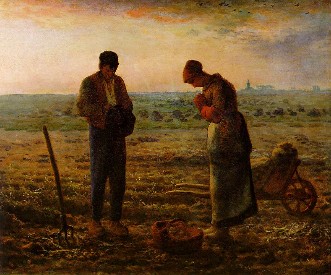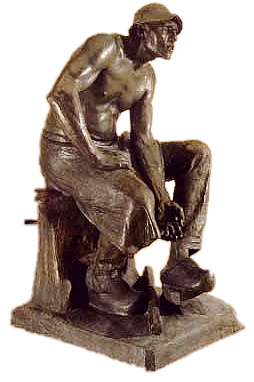|
5. A conservative citizen – a radical artist |
|

Jean-François Millet, The
Angelus, oil on canvas |
Rodin was not the only artist to proclaim the primacy of Nature. From the 1840´s on, Naturalism
becomes the name of a new paradigm in Art. Following up the Realism introduced by Balzac and Flaubert, Emile Zola writes naturalistic novels like
Les Rougon-Macquarts, histoire naturelle et sociale d'une famille sous le second empire. In a long series of books, he unfolds an exhaustive portrait of all possible professions and social fates, including the misery of miners and prostitutes, disease, madness, alcoholism, genetic degeneration, inevitable result of determinist development. Not unlike Rodin, he claims not to select, modify, emphasise in his narration but only to describe the natural course of life in a scientific, unbiased way.
|
|
|
The painter Jean-François Millet (1814-1875), born in a poor farming family, adopted Naturalism by portraying the simple peasants on the field, adding a dimension of social protest. This was later picked up by the preacher’s son Van Gogh, who often copied Millet for his own studies and painted the miners of the Belgian Borinage and their pauperish living conditions.
The painter and sculptor Constantin Meunier (1831-1905), with whom Rodin got acquainted
during his stay in Belgium, also depicted the pathos of manual labour in the same deplorable mining district and created powerful,
expressive bronze figures of miners, field workers and peasants. Rodin, on the contrary, who had spent
long, hard years as a simple craftsman, never stepped in for what was called
“the social cause”.
 Christine Goetz, Studien zum Thema 'Arbeit' im Werk von
Constantin Meunier und Vincent van Gogh, Beiträge zur Kunstwissenschaft, Band
2, Scaneg Verlag, ISBN 3-9800671-2-2.
324 S., 55 Abb. Christine Goetz, Studien zum Thema 'Arbeit' im Werk von
Constantin Meunier und Vincent van Gogh, Beiträge zur Kunstwissenschaft, Band
2, Scaneg Verlag, ISBN 3-9800671-2-2.
324 S., 55 Abb.
 Micheline Hanotelle, Paris/Bruxelles: Rodin et Meunier: relations des
sculpteurs français et belges à la fin du XIXe siècle. Le Temps.
Micheline Hanotelle, Paris/Bruxelles: Rodin et Meunier: relations des
sculpteurs français et belges à la fin du XIXe siècle. Le Temps.
|

Constantin Meunier, The Puddler,
bronze, Musées Royaux des
Beaux-Arts de Belgique, Brussels
|
|
After The Thinker had caught the attention of a broad public, the sculpture was sometimes interpreted as a working class hero awakening to
consciousness:
Democracy has
had its heroes and its statues. But these heroes were often no more than
bourgeois. (...)
The Thinker of Mr Rodin is, on the contrary, the anonymous unknown
worker, the first to come from among the proletariat, whose native
homeliness the artist has exaggerated, again according to the exigencies
and manner of his art (...)
The proletariat will be flattered
... to see itself endowed with thought - the proletariat that is so often
accused of having only blindness and instincts.
 'Le Penseur' de Rodin, L´Univers et le Monde, quoted by Albert Elsen,
in: Rodin´s Thinker and the Dilemmas of Modern Public Sculpture, Yale
University Press, p. 129
'Le Penseur' de Rodin, L´Univers et le Monde, quoted by Albert Elsen,
in: Rodin´s Thinker and the Dilemmas of Modern Public Sculpture, Yale
University Press, p. 129
But during all his life, Rodin himself painstakingly avoided any explicit political commitment.
As a son of a policeman, as an artist competing for state commissions, Rodin may have felt inhibited to support the one or other party. During the Dreyfus affair, Rodin was in the awkward position that his admirers, who tried to collect FF 30,000 to purchase his refused
Balzac Monument and put it at a public space, were mainly supporters of the imprisoned Jewish officer. In his open letter
J´accuse, Zola taunted the military leaders with a conspiracy against the innocent captain. Zola was summoned to court and condemned; the confrontation between the left intellectuals and the conservative forces split the French nation. But Rodin, unwilling to provoke the reigning powers, remained silent and refused to put his name under a manifest to support Zola, so that Jean Ajalbert scolded the stubborn sculptor for cowardice. In fact, Rodin was politically much more conservative than he admitted in public. The Norwegian author and painter Christain Krohg, who visited Rodin at that time,
complained: "Rodin is a glowing anti-Dreyfusard and anti-Semite..." (quoted
by Grunfeld, p. 383).
In the end, Rodin sold his Balzac plaster neither to his friends, who were associated with the Dreyfus camp, nor to the art collector Auguste Pellerin, but kept it for himself. Apart from the necessity, not to insult his most loyal supporters by accepting the Pellerin offer, he must have felt that his work expressed something more profound and universal than the political and social concerns of the day. His protest remains limited to the rigid artistic regime, that denied his entry to the
Ecole des Beaux Arts. His most urgent mission is the innovation of Art, not of society.


|

